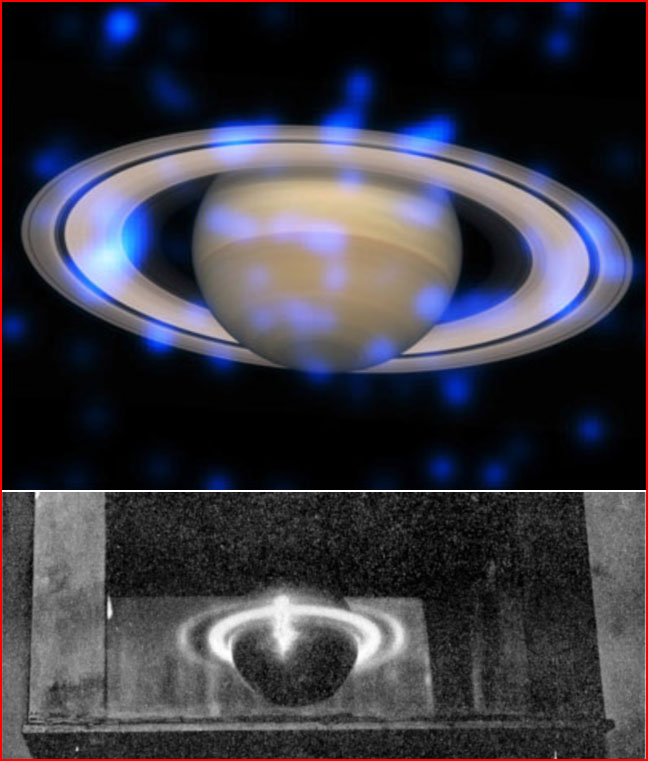
home •
about •
essential guide •
picture of the day •
thunderblogs •
news •
multimedia •
predictions •
products •
get involved •
contact
picture of the day archive subject index
UPPER: Recent image from the Chandra X-Ray Observatory telescope reveals
X-ray emissions from the rings of Saturn.
LOWER: More than 90 years ago, the experimental physicist Kristian Birkeland
produced the "rings of Saturn" in a glowing plasma, using a slightly magnetized 24
cm diameter conducting globe as a cathode in a vacuum discharge. Published in
1913! Electricity is nature's efficient means of X-ray production.
Credit: X-ray: NASA/MSFC/CXC/A.Bhardwaj et al.; Optical: NASA/ESA/STScI/AURA
Sep 01, 2006
Saturn's Rings Sparkle in X-raysOne of the latest images from the Chandra X-Ray Observatory telescope brings another surprise in a year of surprises. The images show that the rings of Saturn “sparkle in X-rays.”
The X-ray emissions are the blue dots in the X-ray/optical composite image above. It appears that the X-rays are brightest on the morning side (left side) of the rings.
According to the Observatory report, “The likely source for this radiation is the fluorescence caused by solar X-rays striking oxygen atoms in the water molecules that comprise most of the icy rings.”
The hypothesized events behind the X-ray production add more complexity to a series of ad hoc rationales for the electrical and “sun-like” behavior of Saturn. It is suggested that the ring X-ray events occur as meteorites pass through the rings, scattering dust and ice out of their narrow plane. The displaced material casts a shadow on the rings (the famous revolving “spokes” of the ring system). The rings catch more solar x-rays, causing more fluorescence.
On this hypothesis, the X-rays are brighter on morning side because from midnight to the early morning hours the relative speed of the rings through a cloud of meteoroids would be greater.
Other Chandra observations of Saturn show that the X-ray brightness of the rings varies significantly from one week to the next.
A different viewpoint is offered by the electrical hypothesis. Planets are minor negatively charged “electrodes” within a stellar discharge envelope. As long ago as 1913, Birkeland performed an electrical experiment using a slightly magnetized 24 cm diameter conducting globe as a cathode in a vacuum discharge. He wrote about the rings of Saturn and their inexplicable thinness: “it seems almost incredible that such a ring of cosmic dust should be able to exist for ever, so to speak, without other governing forces than gravitation.” He compared his remarkable electrical experiment result (seen above) with the rings of Saturn. “... if the discharge-current ... be reduced ... the ring becomes exceedingly thin and sometimes assumes an appearance almost exactly like that of Saturn's rings.”
From the electrical perspective, there is not a crowd of separate anomalies to be explained, but one explanation that answers them all: inexplicable hot spots on Saturn; “astonishing” megalightning; the incongruous “spokes” of the ring system; the plasma torus around the orb of Saturn; Saturn’s radiation belt; the super rotation of Saturn’s atmosphere; Saturn’s X-rays; and (most recently) X-rays from the ring system.
The following brief citations from Wallace Thornhill’s website, www.holoscience.com, are indicative of the general direction of an electrical interpretation of Saturn’s many enigmas. He compares Saturn with a simple Faraday or “homopolar” motor, which has electrons flowing out from Saturn in an equatorial sheet – as Birkeland found experimentally.
“As shown in laboratory experiments, the inflowing [conventionally] electric current forms a plasma donut where the electrical energy is stored. It is that energy that drives the winds and lightning on Saturn.”
“The electromotive power is deposited mostly in the upper atmosphere at mid to low latitudes and gives rise to its ‘super rotation’. That is, the atmosphere races around the planet faster than the planet turns.”
“Score one for the electrical model. It predicted this finding of an inner radiation belt. However, the conventional term ‘radiation belt’ is misleading. The belt is a donut-shaped plasmoid, which stores electromagnetic energy in the form of circulating high-energy charged particles.”
“In fact, Saturn has two plasmoids. One is outside the rings, the other inside the rings. Discharges to Saturn must cross the rings.” [Megalightning at Saturn]
“Saturn’s rings form part of the circuit that feeds energy into its plasa donut, where it is stored before discharging into Saturn’s ionosphere and generating X-rays.” [Cassini's Homecoming]
“As NASA's Cassini spacecraft approached Saturn last July it found evidence that lightning on Saturn is roughly one million times stronger than lightning on Earth. ‘That's just astonishing to me!’ said University of Iowa Space Physicist Don Gurnett.”
The spokes in Saturn’s rings are caused by “lightning discharges” radially across the rings. That temporarily moves ice and dust out of the rings plane. The X-ray spots from the region of Saturn’s rings are primarily a result of lightning across the rings. Fluorescence from solar radiation should be more diffuse.
[Concerning the polar “hot spot” on Saturn]: “Its compactness is due to the electromagnetic pinch effect where it [electric current] enters Saturn’s atmosphere. The hot spot's behavior should be variable, like that on Venus, and correlated with the appearance of Saturn's ring spokes, which are a visible manifestation of a heightened equatorial discharge in that part of Saturn's Faraday motor circuit.” [ Saturn's Strange Hot Spot Explained]
___________________________________________________________________________Please visit our Forum
The Electric Sky and The Electric Universe available now!

|
|

|
EXECUTIVE EDITORS:
David Talbott, Wallace Thornhill
MANAGING EDITORS:
Steve Smith, Mel Acheson
CONTRIBUTING EDITORS: Dwardu Cardona, Ev Cochrane,
C.J. Ransom, Don Scott, Rens van der Sluijs, Ian Tresman
WEBMASTER: Brian Talbott
Copyright 2006: thunderbolts.info
![]()
home •
thunderblogs •
forum •
picture of the day •
resources •
team •
updates •
contact us

